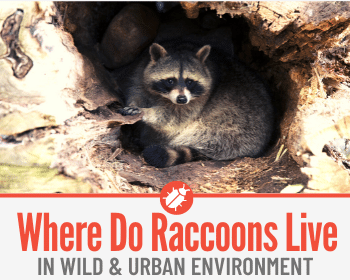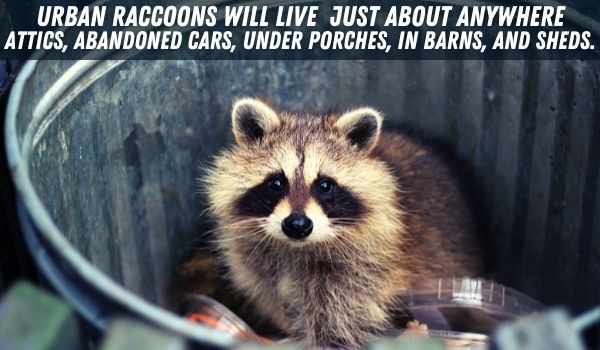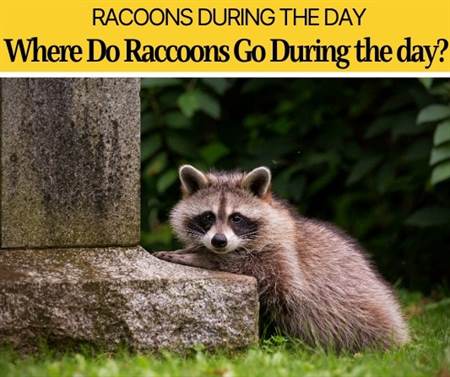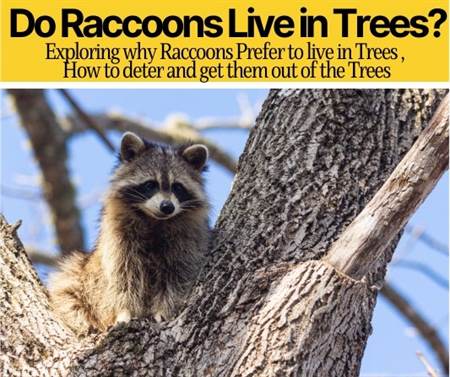 Wondering Where do Raccoons actually live and what do they do apart from digging through our trash bins at night?
Wondering Where do Raccoons actually live and what do they do apart from digging through our trash bins at night?
In this guide you will learn:
- Where Do Raccoons Live ,both in urban & wild environments,
- Where Do they Make their Dens , Nest & Burrow,
- Whatever Raccoons live in packs or alone,
- Where do Raccoons Sleep During the Day or Night
Where Do Raccoons Live?
Raccoons live in nests called dens.
A raccoon’s nest is commonly called a den. Even though a raccoon may build a nest inside of its den, the terms are still used synonymously.
A Raccoon will live in anything it can find that provides overhead shelter from the weather and from nearby humans.
Being native to North America, raccoons can be found living all across the United States, except in the Rocky Mountains and the southwestern states of Arizona, Nevada, and Utah.
While they generally prefer the deciduous and other forests of North America, raccoons are able to easily adapt to new climates.
This ability helped them migrate north into parts of Canada and even as far as Alaska.
To the south, they can be found in Mexico and in the northern parts of South America.
Raccoons live almost all over the world. On the other side of the globe, raccoons are everywhere from Germany to Russia to Japan.
In Wild
Because raccoons are omnivorous, meaning raccoons will eat meat and plants, raccoons in the wild will live wherever they can find food and a place to call their den.
The raccoon’s optimal living habitat is heavily-wooded areas with large, tall trees, thick shrubbery, and plenty of water nearby.
Raccoons living in wild usually build their den and live in sheltered areas ranging from a fallen log, to a hollowed tree, to under rocks, to piles of leaves.
But, they have also been known to move to towns and cities in search of food.
Having become accustomed to urban life, raccoons are now found more and more in cities and not only in the wild.
The raccoon’s ability to adapt to any environment, from mountainous forests to big cities, has led them to be able to live almost anywhere.
In Urban Environment
Urban raccoons have a different demeanour than native raccoons.
While native raccoons are usually shy with a natural fear of humans, urban raccoons have become more bold and aggressive from living in closer proximity to humans.
While the middle of a town or a big city may not seem like the best place for a raccoon to live, raccoons definitely seem to think so.
Even though they prefer wooded areas, the growth of cities and suburban areas have forced raccoons to become accustomed to living in a urban environments.
In the City ,Raccoons usually will find places to live in such as sheds, abandoned barns, chimneys,storm drains,attics and even under your house.
Urban raccoons usually do have multiple dens where they spend their time.
Often, raccoons will live just outside the city during the day.
Then at night, they’ll travel into the city to forage for food, most often digging through dumpsters.
Aggressive Fighters
Urban raccoons can look fairly innocent, but when approached can quickly turn defensive. If feeling threatened, these raccoons will claw, bite, and scratch to defend themselves.
Because a raccoon’s bite or scratch can easily become infected, it is best to keep pets and children away from raccoons.
Disease Carriers
Raccoons are dangerous because they carry many diseases that they can transmit to you, your children, or your pets through biting or scratching.
Because raccoons belong to the family Procyonidea, they have a unique family heritage that makes them susceptible to diseases like rabies, Parvo, and distemper. These diseases can be fatal to cats and dogs.
It is important to know that urban raccoons can carry the rabies virus without showing any visible signs. They can live a full, normal life without showing any symptoms and without dying shortly after getting the virus.
Raccoons also carry parasites, mites, and other diseases.

In Winter
In the winter, raccoons live in the dens they made just before winter began.
Even though raccoons don’t hibernate, they do hunker down in a mild form of hibernation called torpor.
Just before winter, raccoons double their body size to prepare for winter.
Then, they hunker down in their den to sleep, stirring minimally to conserve warmth.
At times, raccoons will leave their den to go hunt for food, often returning rather quickly due to the cold.
How Many Raccoons Live Together – Do They Live in Packs?
Male and female raccoons live in their own separate groups or packs.
Females join a group of other females called a “fission-fusion” group where they are able to rest and eat in a common place without worrying about predators.
Males form their own groups called “bachelor groups.” Often, these males will have overlapping territories, share dens, and even socialize with each other.
There are usually 4 to 5 male raccoons in a bachelor group.
The females, however, usually live in larger groups, often containing young raccoons.
While raccoons can often be solitary during the summer, the winter forces them to group up and live in Packs.
The ability to huddle together to conserve heat, hunt together to find more food, and protect each other from predators makes these groups a must during the winter.
Where Do Raccoons Sleep & How do they Sleep
When the time comes for a raccoon to sleep, it will either head back to one of its dens or it will hunker down in a secure place outside.
Even aside from being nocturnal and sleeping while the world is wide awake, raccoons have fairly normal sleeping habits.
In fact, Raccoons are actually fairly optimistic about finding a place to sleep.
Raccoons are not very picky about where they sleep at all.
Anywhere from up in a tree to under a front porch.
Raccoons will sleep Anywhere that they are out of sight and danger from predators throughout the day works fine for raccoons.
In the wild, they prefer to sleep in hollowed trees and logs.
But in urban environments, they sleep just about anywhere—attics, abandoned cars, under porches, in barns, and sheds.
It is interesting to note that raccoons will change their den frequently.
Some raccoons will even find a new den every night.
The first night he might hunker down in a cozy log on the forest floor and the next night he’s in some farmer’s attic.
However, during winter and breeding seasons, raccoons tend to stay in their den for a longer period of time.
Additionally, Raccoons are very heavy sleepers. They have been known to be hunkered down sleeping next to a road, undisturbed.
During the Day
Because raccoons are mainly nocturnal animals, they often sleep during most of the day.
During the day, raccoons usually sleep in their den or in the hollow of a tree or log.
They are also known to sleep in the nests they’ve built in a tree to avoid predators sneaking up on them during the day.
At Night
Because they’re nocturnal, raccoons do not usually sleep during the night.
Around sunset, most raccoons leave their dens in search for food, heading straight towards the nearest source that they know of.
The best sources for raccoons to find food are farms, rivers, lakes for insects and fish, or fields and farms because of the fresh supply of corn and other vegetables.
In urban environments, their favorite source of food is most definitely the dumpster or the trash can.
This is why it’s important to keep your trash cans closed and sealed to deter raccoons.
If you are wondering how long do raccoons sleep…
Raccoons often prefer to sleep the whole day away.
While this makes sense because the raccoon is nocturnal and hunts during the night, from dusk until dawn.
Do Raccoons Burrow?
Raccoons do indeed burrow, Raccoon’s unique paw shape and strong fingers allow it to burrow through almost anything.
Their nimble little fingers help them burrow and dig holes that can be as small as 3 inches deep and as wide as 10 inches.
They are also able to squeeze into and move around in really small, compact places, meaning their burrows can be in the most unlikely places.
Raccoons will burrow for two reasons: to build their den and to find food.
To Build Their Den
If a raccoon is not able to find a place to hunker in as their den, raccoons will burrow into the ground to make themself a den.
Their strong claws let them dig through all sorts of materials, allowing them to dig their den anywhere.
Some common examples of places raccoons have burrowed their den include: yards, brush piles, rock crevices, storm drains, and hollow trees.
To Find Food
Raccoons also burrow to find food.
Because they are omnivorous, raccoons will dig to find food such as insects, grubs, fruits, berries, corns, and grains.
They have even been known to dig up eggs that other animals have buried underground.
Raccoons will even dig through compost piles and garbage cans to find leftover human food and the insects drawn to the trash.
Do Raccoons Make Nests?
Yes, raccoons make nests.
Especially in the fall, raccoons will gather supplies such as hay, twigs, brush, and leaves to build a nest or den.
Nests are most often made by pregnant female raccoons who are looking for a place to give birth to her litter.
Raccoon nests are not usually seen much on their own because the nest is usually located inside the den.
However, especially when a raccoon nests in a tree, a haystack, or in some form of brush, their nest is easy to spot.
Interestingly, during the winter, raccoons have been known to share dens with other animals, including skunks.
If you are wondering what do Raccoons Nests Look like, A raccoon’s nest will look very similar to any other kind of animal nest.
From the outside, it looks like a lump of grasses or hay.
Sometimes, raccoons will bring back strips of cloth or fabric that they’ll add to the outside of the nest.
On the inside, the nest is much more cozy. The inside will be lined with some sort of insulation, whether that be soft grasses or dirt.
In urban environments, raccoons will shred wall insulation, couch stuffing, or blankets and bring it back to line the inside of its nest.
Where Do Raccoons Nest?
Raccoons nest almost anywhere. Everything from storm sewers to crawl spaces to chimneys to attics are fair game.
The most popular places for raccoons to nest in the wild are in the cavities of trees or fallen logs, especially when in a secluded area of the forest near running water.
In urban environments, the raccoon’s favorite places are anything that can provide some amount of heat and that will shelter from wind, rain, and snow.
Often, raccoons will have several different dens available to them at any one time.
Because they are such highly-opportunistic animals, raccoons will often move into an abandoned or empty nest of another animal.
Some Raccoons are even known to live underground…
Female raccoons seem to prefer building their nests in trees, in already existing shelters (such as a hallowed tree or log), and in urban shelters.
Males, however, seem to enjoy nesting underground or near the ground.
Why Do Raccoons Have So Many Nests?
Because raccoons are always on the move, they will often have several different options of dens to choose from.
Raccoons have been known to travel over 18 miles to find food.
Because of this, raccoons are often not in the same place for more than one night, unless it is a pregnant mother.
Females often travel less than their male counterparts, usually traveling in a group of other females.
Additionally, raccoons do not usually stay in a den for longer than one or two days. The exceptions to this are if the raccoon is pregnant, has young kits, or during the winter.
Similarly, when a female raccoon gives birth to her litter, she will usually remain in that den until her kits are old enough to travel.
However, if she has been disturbed or threatened, she will remove her litter to another den.
Will a Raccoon Use the Same Nest Twice?
Yes. Just because the raccoon left the den or nest does not mean it will never return. Raccoons often re-use dens.
Additionally, pregnant females will often return to the den in which they were born to give birth to their own young.
Because the raccoon can remember something for up to three years, the female has no problem remembering the place of her birth and returning to use it as the den for her own litter.
Raccoon Nests in Trees
Often, raccoons will make their nest, or den, in trees.
With their hands especially made for gripping, raccoons are excellent climbers and prefer to nest in trees.
Most often, mothers with young kits will make their nest in a tree high enough away from predators.
While they’re young, the kits remain in the nest while the mother goes hunting.
Related Questions.
When Do Baby Raccoons Leave the Nest?
Baby raccoons live in the nest with their mother for a few months until they are old enough and skilled enough to hunt with her.
They will then hunt with their mother for a few more months yet before leaving the nest to be completely on their own.
Do Raccoons Live in the Sewer?
Raccoons do not usually live in the sewer, even though they are found in the sewers quite often. Because of the high amounts of hydrogen sulfide, raccoons are not able to survive for long in the sewer.
So, if raccoons do not live in the sewer, why are they down there?
Scavenging for Food
As scavengers, raccoons will go almost anywhere in search of food, and especially human food. Often, this means the sewers because food will often get dropped into drains and will slowly make its way to the sewer.
Traveling through the City
Raccoons will often use sewers and storm drains as a quick and easy way to travel through a city without the danger of cars and humans.
Sometimes, they can get stuck down there and cannot find their way out.
Do Raccoons Live in Armadillo Holes?
Because raccoons are such optimistic animals, they will live anywhere—even in another animal’s hole or den.
Furthermore, because the armadillo burrows holes and makes dens similar to the raccoon, raccoons often live in armadillo holes—especially during the winter.






